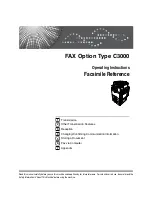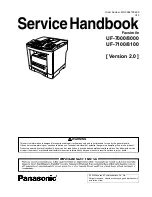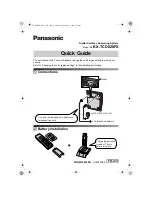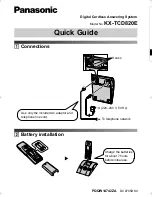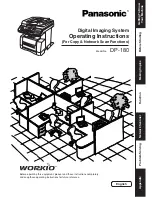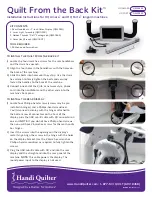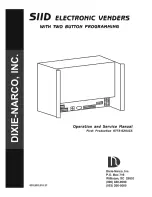
10
SIGNS OF INADEQUATE ELECTRICAL POWER
(LOW VOLTAGE) ARE:
Noisy hoist operations due to brake and/or
contactor chattering.
Dimming of lights or slowing of motors connected
to the same circuit.
Heating of the hoist motor and other internal
components as well as heating of the wires and
connectors in the circuit feeding the hoists.
Failure of the hoist to lift the load due to motor
stalling.
Blowing of fuses or tripping of circuit breakers.
To avoid these low voltage problems, the hoist must be
connected to an electrical power supply system that com-
plies with the National Electrical Code and applicable local
codes. This system must also be rated for a minimum of 20
amps and it must have #14 AWG (2.0 mm) or larger wiring,
a disconnecting means, overcurrent protection (slow blow
fuses or inverse-time circuit breakers) and provisions for
grounding the hoist.
Low voltage can also be caused by using an undersize
extension cord to supply power to the hoist. The following
chart should be used to determine the size wires in the
extension cord in order to minimize the voltage drop
between the power source and the hoist.
Remember, operation with low voltage can void the CM
repair/replacement policy. When in doubt about any of the
electrical requirements, consult a qualified electrician.
Always disconnect the power from the power supply system
and lockout/tagout disconnecting means befores before
servicing the hoist.
L
L
!!
WARNING
Failure to properly ground the hoist presents the danger of
electric shock.
TO AVOID INJURY:
Permanently ground the hoist as instructed in this Manual.
L
LE
EN
NG
GT
TH
H
O
OF
F
E
EX
XT
TE
EN
NS
SIIO
ON
N
C
CO
OR
RD
D
S
SIIN
NG
GL
LE
E
P
PH
HA
AS
SE
E
H
HO
OIIS
ST
TS
S
T
TH
HR
RE
EE
E
P
PH
HA
AS
SE
E
H
HO
OIIS
ST
TS
S
M
MIIN
NIIM
MU
UM
M
W
WIIR
RE
E S
SIIZ
ZE
E
M
MIIN
NIIM
MU
UM
M
W
WIIR
RE
E S
SIIZ
ZE
E
U
UP
P T
TO
O 5
50
0 F
FE
EE
ET
T
((1
15
5..2
2 M
M))
#
#1
14
4 A
AW
WG
G
((1
1..6
6 m
mm
m))
#
#1
16
6 A
AW
WG
G
((1
1..3
3 m
mm
m))
8
80
0 F
FE
EE
ET
T
((2
24
4..1
1 M
M))
#
#1
12
2 A
AW
WG
G
((2
2..0
0 m
mm
m))
#
#1
16
6 A
AW
WG
G
((1
1..3
3 m
mm
m))
1
12
20
0 F
FE
EE
ET
T
((3
36
6..7
7 M
M))
#
#1
10
0 A
AW
WG
G
((2
2..6
6 m
mm
m))
#
#1
14
4 A
AW
WG
G
((1
1..6
6 m
mm
m))
L
L
!!
WARNING
Failure to provide a proper supply system for the hoist may
cause hoist damage and offers the potential for a fire.
TO AVOID INJURY:
Provide the hoist with a 20 amp, minimum, overcurrent
protected power supply system per the national Electrical
Code and applicable local codes as instructed in this Manual.
C
CH
HE
EC
CK
KIIN
NG
G L
LIIM
MIIT
T S
SW
WIIT
TC
CH
H O
OP
PE
ER
RA
AT
TIIO
ON
N
Operate hoist over the entire length of its rated lift, checking
upper and lower limit switches for correct operation as
follows:
1.
Press
(UP) control and raise the lower hook until
top of hook block is about one foot below the hoist.
2.
Cautiously continue raising the hook until the upper
limit switch stops the upward motion. The upper
limit switch is set at the factory to stop the hook
block 3 inches (76.2 mm) from bottom of the hoist
on all units with standard 10 foot ( 3 M) lift except
Models AA and AA-2. Factory setting is 6 inches
(152.4 mm) for these models and for all other mod
els equipped with chain for lifts longer than 10
feet(3 M).
3.
If adjustment is necessary, see page 17.
4.
Press
(DOWN) control and cautiously lower hook
until lower limit switch stops the downward motion.
From 7 to 11 chain links (depending on hoist
model) should be between the loose end link and
the hoist entry. See Figures 7 and 8.
5.
If adjustment is necessary, see pages 16-17.
N
NO
OT
TE
E:: IIff tth
he
e h
ho
oiis
stt iis
s e
eq
qu
uiip
pp
pe
ed
d w
wiitth
h a
a c
ch
ha
aiin
n
c
co
on
ntta
aiin
ne
err rre
es
se
ett tth
he
e u
up
pp
pe
err a
an
nd
d llo
ow
we
err lliim
miitt s
sw
wiittc
ch
he
es
s
a
as
s iin
nd
diic
ca
atte
ed
d o
on
n p
pa
ag
ge
e 1
17
7.. S
Se
ett tth
he
e u
up
pp
pe
err lliim
miitt s
sw
wiittc
ch
h
s
so
o tth
ha
att tth
he
e u
up
pp
pe
errm
mo
os
stt p
po
oiin
ntt o
off h
ho
oo
ok
k ttrra
av
ve
ell iis
s jju
us
stt
b
be
ello
ow
w tth
he
e b
bo
otttto
om
m o
off tth
he
e c
ch
ha
aiin
n c
co
on
ntta
aiin
ne
err.. S
Se
ett tth
he
e
llo
ow
we
err lliim
miitt s
sw
wiittc
ch
h s
so
o tth
ha
att tth
he
erre
e iis
s a
a m
miin
niim
mu
um
m o
off tte
en
n
lliin
nk
ks
s s
sh
ho
ow
wiin
ng
g b
be
ello
ow
w tth
he
e b
bo
otttto
om
m iiff tth
he
e h
ho
oiis
stt w
wh
he
en
n
tth
he
e h
ho
oo
ok
k iis
s a
att iitts
s llo
ow
we
es
stt p
po
os
siittiio
on
n..
U
Un
nd
de
err n
no
o c
co
on
nd
diittiio
on
n s
sh
ho
ou
ulld
d tth
he
e h
ho
oo
ok
k b
bllo
oc
ck
k o
orr llo
oa
ad
d
b
be
e p
pe
errm
miitttte
ed
d tto
o c
co
om
me
e iin
n c
co
on
ntta
ac
ctt w
wiitth
h tth
he
e c
ch
ha
aiin
n
c
co
on
ntta
aiin
ne
err.. IIff c
co
on
ntta
ac
ctt iis
s m
ma
ad
de
e,, tth
he
e ffu
un
nc
cttiio
on
n o
off tth
he
e
c
ch
ha
aiin
n c
co
on
ntta
aiin
ne
err c
ca
an
n b
be
e iin
ntte
errffe
erre
ed
d w
wiitth
h a
an
nd
d iitts
s
ffa
as
stte
en
ne
errs
s iim
mp
pe
erriille
ed
d..
CONTROL CORD
Unless ordered on a special basis, the hoist is supplied with
a control cord that will position the control station approxi-
mately 4 feet above the lower hook when it is at the lower
limit of the lift. If this places the control station too close to
the floor, a “control cord alteration kit” (Key No. 627-474, Part
Number 28642) can be obtained from CM for shortening the
length of the control cord.
WARNING
Working in or near exposed energized electrical equipment
presents the danger of electric shock.
TO AVOID INJURY:
DISCONNECT POWER AND LOCKOUT/TAGOUT
DISCONNECTING MEANS BEFORE REMOVING COVER OR
SERVICING THIS EQUIPMENT.
L
L
!!
WARNING
Allowing the hook block to run into the bottom of the hoist
when raising a load or allowing the chain to become taut
between the loose end screw and the frame when lowering the
load may break the chain and allow the load to drop.
TO AVOID INJURY:
Do not allow the hook block to contact the bottom of the hoist
or the loose end chain to become taut.
L
L
!!
WARNING
Tying knots or loops to shorten the drop of the control station
will make the strain relief ineffective and the internal
conductors of the cord may break.
TO AVOID INJURY:
Shorten the control cord using the control cord alteration kit
and the instructions provided with the kit.
Summary of Contents for CM Hoist
Page 28: ...24 WIRING DIAGRAMS MODELS A AA B C E F H 110 115 1 50 60 VOLT...
Page 29: ...25 WIRING DIAGRAMS MODELS A AA B C E F H 220 230 1 50 60 VOLT...
Page 30: ...26 WIRING DIAGRAMS MODELS A AA B C E F H 220 230 3 50 60 OR 380 415 460 3 50 60 VOLT...
Page 31: ...27 WIRING DIAGRAMS MODELS A AA B C E F H 220 230 3 50 60 OR 380 415 460 3 50 60 VOLT CSA UNITS...
Page 32: ...28 WIRING DIAGRAMS MODELS A 2 AA 2 B 2 C 2 E 2 F 2 H 2 220 230 3 50 60 VOLT...
Page 33: ...29 WIRING DIAGRAMS MODELS A 2 AA 2 B 2 C 2 E 2 F 2 H 2 220 230 3 50 60 VOLT CSA UNITS...
Page 34: ...30 WIRING DIAGRAMS MODELS A 2 AA 2 B 2 C 2 E 2 F 2 H 2 380 415 460 3 50 60 VOLT...
Page 35: ...31 WIRING DIAGRAMS MODELS A 2 AA 2 B 2 C 2 E 2 F 2 H 2 380 415 460 3 50 60 VOLT CSA UNITS...
Page 36: ...32 WIRING DIAGRAMS MODELS A AA B C E F H 550 575 3 50 60 VOLT...
Page 37: ...33 WIRING DIAGRAMS MODELS A AA B C E F H 550 575 3 50 60 VOLT CSA UNITS...
Page 38: ...34 WIRING DIAGRAMS MODELS A 2 AA 2 B 2 C 2 E 2 F 2 H 2 550 575 3 50 60 VOLT...
Page 39: ...35 WIRING DIAGRAMS MODELS A 2 AA 2 B 2 C 2 E 2 F 2 H 2 550 575 3 50 60 VOLT CSA UNITS...
Page 40: ...36 WIRING DIAGRAMS MODELS J L R RT 110 115 1 50 60 VOLT...
Page 41: ...37 WIRING DIAGRAMS MODELS J L R RT 220 230 1 50 60 VOLT...
Page 42: ...38 WIRING DIAGRAMS MODELS J JJ L LL R RR RT RRT 220 230 3 50 OR 380 415 460 3 50 60 VOLT...
Page 44: ...40 WIRING DIAGRAMS MODELS J 2 JJ 2 L 2 LL 2 R 2 RR 2 RT 2 RRT 2 220 230 3 50 60 VOLT...
Page 45: ...41 WIRING DIAGRAMS MODELS J 2 JJ 2 L 2 LL 2 R 2 RR 2 RT 2 RRT 2 220 230 3 50 50 VOLT CSA UNITS...
Page 46: ...42 WIRING DIAGRAMS MODELS J 2 JJ 2 L 2 LL 2 R 2 RR 2 RT 2 RRT 2 380 415 460 3 50 60 VOLT...
Page 48: ...44 WIRING DIAGRAMS MODELS J JJ L LL R RR RT RRT 550 575 3 50 60 VOLT...
Page 49: ...45 WIRING DIAGRAMS MODELS J JJ L LL R RR RT RRT 550 575 3 50 60 VOLT CSA UNITS...
Page 50: ...46 WIRING DIAGRAMS MODELS J 2 JJ 2 L 2 LL 2 R 2 RR 2 RT 2 RRT 2 550 575 3 50 60 VOLT...
Page 51: ...47 WIRING DIAGRAMS MODELS J 2 JJ 2 L 2 LL 2 R 2 RR 2 RT 2 RRT 2 550 575 3 50 60 VOLT CSA UNITS...
Page 57: ...53 Notes...
Page 62: ...58 LODESTAR LOWER HOOK BLOCK ASSEMBLY...
Page 89: ...85 NOTES...
Page 93: ...89 NOTES...






























